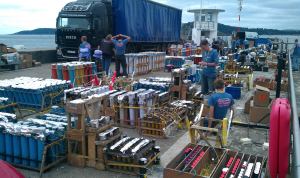What happens inside a firework?
It’s very nearly time for Bonfire night! In just a few short days, we’ll be popping on our woollies and heading out to enjoy the warmth of a bonfire and a sky full of whizzing, crackling, booming fireworks in all their incredible varieties.
As you plan your fireworks displays or find out what bonfire night events are on in your local area, let’s take a second to marvel at the wonders of fireworks. What happens to produce those awesome lights and colours, and how on earth do fireworks make those exciting booms, bangs and crackles? It’s all down to that highly explosive substance that was central to the Guy Fawkes plot that created our modern-day Bonfire Night – gunpowder.
Getting up into the sky
Many fireworks appear teeny tiny, making it even more wondrous that they manage to shoot many metres up into the air. How do they do it? It all starts once the fuse is lit. This sets off a charge, which ignites the gunpowder, creating gases that propel the firework into the sky at a storming speed. This explosive reaction is needed to create the power that fires the explosive up where everyone from miles around can see it.
Creating colours, lights and effects
Inside another part of the firework, there may be a few different compartments, all containing gunpowder that ignites at different times. This is how you get such a wide range of effects depending on whether you’re firing a rocket, Roman candle, fountain or even an aerial shell. The ignited gunpowder creates ‘stars’, which are actually made up of iron filings and metal salts. These explode in different colours, and depending on how they are positioned around the central gunpowder, a range of different crowd-pleasing patterns too.
This is just one of the reasons why it’s so important to buy good quality, accredited fireworks from a reputable supplier. The firework needs to be made properly, so that the ‘stars’ are perfectly positioned to create the right pattern. Good quality fireworks also produce far less smoke (which can completely ruin a display, especially on a windy night!) and are less likely to mis-fire or fail to launch.
The differences between fireworks
Of course, different fireworks work in slightly different ways. For example, a fountain sits on the ground and isn’t fired into the air. It shoots colourful sparks into the air through a hole in the top where gases can escape. Meanwhile, Roman candles shoot balls of chemicals from one end, so that you see a series of flaming stars. These chemical balls are layered one on top of another inside the firework, with sawdust in between each pair.
Have a fantastic Guy Fawkes Night!
So there you go, that’s how fireworks work. We all enjoy them on November 5th and for special celebrations year after year, but it’s amazing how many people don’t stop to think about how it all works. Don’t worry – knowing won’t spoil the magic, it’ll just give you some good facts to tell people about at parties!

